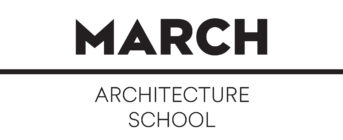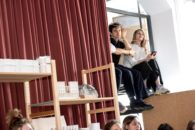
10 N. Syromyatnicheskaya St., building 2
Moscow, Russia 105120
RU
N 55° 45' 7.27'', E 55° 45' 7.27''
https://march.ru/
Dean of the School
Master
March was founded in 2012 in Moscow to introduce a new model of high-quality architectural education. It is a unique educational centre specialising in an international educational programme in the field of architecture and urbanism. The School was developed in partnership with the Sir John Cass Faculty of Arts, Architecture and Design of London Metropolitan University (LMU). MARCH strives to create a new model of architectural education in Russia, focused on generating thinking, competent and responsible individuals, educated to the highest international level and integrated into the global architecture community. To achieve the highest standards of education we invite best Russian and international architects with broad professional expertise as tutors and curators. Today MARCH offers two main educational programmes: the Bachelors Degree and Masters in Architecture and Urbanism
validated by LMU and conform to international standards of architectural education. Both programmes provide essential training and prepare highly qualified architects. Graduates receive awards corresponding to the British BA and MA in Architecture and Urbanism, after which they can begin a successful career in leading architectural companies in Russia and other countries.
MARCH is not just a name, it's the motto of our school! It speaks of vitality, dynamism, energy and motivation. The combination of the high academic quality of our study programmes and our outstanding team of tutors is what defines our architectural school.
KEY VALUES
- The integration of the School in the global architectural process
- Use of the best international experience in architecture and urban planning to address the existing problems of Russian architecture
- Supporting for creative experiments, professional discussion and for our students' independent modes of thinking
- Involvement of leading Russian and international experts in teaching, discussion and the evaluation of projects
- Understanding of architecture and urban planning as humanitarian and socially responsible activities, that work primarily to answer basic human needs
- Use of advanced design and construction technologies for the realization of the fundamental values of architecture
MARCH is small school with about 100 students in BA programme and 50 in MA The School's premises are located in Design Centre Artplay on the Yauza river. Artplay is a unique place
for Moscow organized on the principle of a creative hub and gathered well-known architects and designers offices, galleries and showrooms, cafes and restaurants under. Artplay is populated with warehouse type industrial spaces, now being refurbished and occupied by a diverse range of creative businesses which reflect the creative dynamism of the city and in particular within the surrounding area, which has become known as the creative quarter. The School is part of Universal University – creative industries education consortium. It includes British High School of Design, Moscow Schools of Filming, of Music, of Advanced Comunication and Screem School specialized in computer graphics. Thanks to it School has a number of specially-equipped studios and workshops for students across a range of art and design courses.
150 students (100 Bachelor, 50 Master, 0 PhD), 0% of foreign students.
- Learning resource centre + electronic access to LMU library
- Centre for model-making and prototyping
- Clay workshop
- Printmaking & silkscreening workshop
- Digital photo and video studios
- Dark room
- Roland DG Academy
- Light laboratory
- Rental shop
- Apple Macintosh and PC Suites
Is not provided by MARCH, but it can assist in finding roommates among students and new entrants.
Admission Requirements
Please contact the school for full information.
Tuition fees
Full-time 380 000 roubles + GBP 850 / year *
Students as a rule pay their tuition fees once a semester, that is, twice a year, but at their request can choose to pay on a monthly basis.
*LMU registration fee.
Application Dates
There are 4 dates during summer (one in a month) and first part of September to apply
Master, Architecture and Urbanism, 2-year, Master,
There is 3year undergraduate and 2year postgraduate programmes. Both are structured in a few interdisciplinary modules with problem based tasks in design studios.
Undergraduate programme includes three years of Critical and Contextual studies module, two years of Technology module, and all years studio based teaching of professional skills and design process. The diploma year is accompanied with the Integrated Design Audit module that helps students to check their designs in such special contexts as sustainability, urban development and so on.
The postgraduate programme includes two studio based modules that leads to some learning outcomes connected to research skills and professional architectural skills. There is massive module “Technology in architecture and urbanism” that unites lessons on digital culture, urbanistic practicum, sociology lectures and engineering studies. “Professional studies” module gives information on legislation connected to architectural practice and at the same time stimulates the discourse about future of profession, the last is supported also by two humanity modules that represent architecture as part of bigger cultural context.
Course aim is to introduce basic process of design for architecture and urban space, the scope and scale of architecture and urban design through design projects, introduce structural design, material properties and selection, building services and environmental design, design and construction of building elements and components. It provides a range of studies that address the history and theory of architecture, character and conditions of cultural production including how they operate in practice.
Course is to prepare students as independent thinkers, capable of selecting an appropriate topic and producing a sustained piece of independent study. Course allows the student to demonstrate their ability as an architectural designer: their capacity to define and analyze architectural problems, generate briefs and proposals, integrate knowledge derived from different fields and sources, produce socially relevant habitable spaces, enrich the built and natural environment, and design technically competent buildings of aesthetic quality.
The educational strategy of the course is rooted in three important principles: the commitment to a deep understanding of architecture; a high degree of personal motivation; and the experience of a shared culture of learning. Aims are summarised as follows in sub-headed areas:
Design Education
To provide a high quality design based education which allows a student to:
- understand the requirements of, and develop methods of engagement with, building users and procurers in order to develop an appropriate and relevant brief which takes into account social, political, economic, ethical and cultural issues.
- develop a sophisticated design process which answers the requirements of the brief and generates a clear and precise conceptual rationale, against which design proposals can
be tested. - develop a complex design scheme which is clear about how it can be realised
- technically, politically, economically and over time, and which integrates knowledge gained in the other key areas of the curriculum below.
- understand how to integrate architecture effectively into its larger urban context
Design, Technology + Environment
Understand and demonstrate within a design proposal an ability to integrate knowledge of:
- structural, constructional and material strategies within the design and the construction techniques and processes necessary to realise the design.
- principles of visual, acoustic and thermal environments, and relationship to climate
- relationship between the design and the wider environment in terms of energy
- consumption, sustainability and ethical development issues.
- provision and integration of building services.
- relationships between individual buildings and wider urban setting and context.
- digital technologies for visualisation, form-finding and presentation.
Practice, Profession and Context
Understand the full range of responsibilities within the remit of the professional architect in terms of:
- legal, statutory, economic, management ethical, social and political obligations.
- understand methods of procurement and delivery of architectural projects
- develop methods of negotiation and team working with all individuals encountered within the practice of architecture; from members of the user group, to client, to specialist consultant, to contractor.
- demonstrate an understanding of the histories and theories of architecture and urbanism that guide and support the design.
- develop an attitude toward these many and various obligations within project design work and integrate this knowledge into the design proposals.
- develop an understanding of Building Information Systems (BIM) as these impact on design practice
- show an ability to use visual, verbal and written forms of communication effectively to communicate with different audiences
Culture
- To provide a lively and energetic environment which encourages students to get involved with, and to contribute to, their subject through events, exhibitions, visiting individuals and groups, action research and international links.
- To emphasise socially-committed design practices in design project work and to encourage students to engage with the ethical dimensions of architecture through links with the city and its communities.








